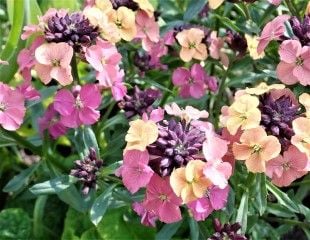
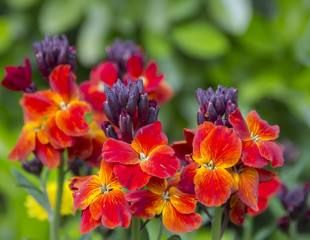
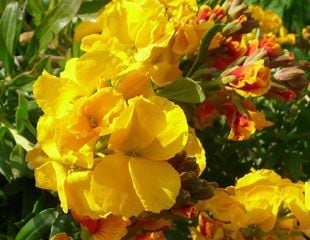
Growing Wallflowers Erysimum
Wallflowers are one of the most highly scented garden plants, which are often overlooked, perhaps because of their association with cottage gardens. Teamed up with spring bulbs, they look and smell lovely.
Varieties of wallflowers can be annual, biennial or perennial, although it's true to say the best scented varieties are biennial. Wallflowers are available in a host of lovely shades of reds, orange, russet, pinks, apricot, purple, and in subtle shades. Select the right variety of wallflowers and enjoy their amazing scent throughout a long flowering period from spring to early summer.
Wallflowers are easy to grow and need little more than a sunny spot and well-drained soil. They are not fussy about soil types and will grow in average soil. The biennial varieties are best treated as bedding and, once flowering has finished, put in the compost. Some varieties will produce flowers another year, but the plants do not always look at their best in successive years.
Wallflowers are suitable for coastal gardens for advice on plants suitable for gardening by the sea side
Ideas for other spring and summer flowering plants check out the 20 best scented plants.
How to Grow Wallflowers
There are two easy ways to grow wallflowers.
You can grow them from seed outside in late spring, and plant out in the garden in autumn, and they will flower the next year.
Alternatively, you can buy wallflowers as inexpensive bare-rooted cuttings in the Autumn. Plant out to establish roots and growth over the Autumn and winter ready for flowering in the spring. Autumn planted Wallflowers can look weedy when first planted out, but they soon get established and do well in the spring. Bare rooted plants benefit from a good soak before planting. Given that Wallflowers are mainly biennial and short-lived, it is more economical to buy them as bare-rooted plants as compared to the fully grown container plants, which are sold later in the year/early spring in garden centres.
September/October is a good time to buy and plant bare rooted wallflowers. I purchased Wallflower 'Harlequin Mixed' from Suttons,(affiliate link) which they will despatch by the end of October along with Tulip 'Fire Wings'. This will produce a lively, bold spring display.
Wallflowers will tolerate partial shade. The perennial varieties need to be pruned to maintain shape and increase flowering.
They are native to Europe, South Ashia, Africa and are H4 hardy which makes them hardy through most winters in the UK down to around -10C.
How to Prune Wallflowers
Pruning wallflowers helps to keep them in shape and stops them from getting leggy. The bedding type wallflowers (not perennials) only need to be pinched out when young to train the plant into a bushy shape. Dead head the plants after flowering, which will encourage a later flush of flowers. This type of wallflower tends to only look good and flower for the one season.
The perennial variety, the most commonly grown of which is E. Bowle's mauve, illustrated bottom left, requires an annual prune. Pruning 'Bowle's Mauve' at the end of the season around October time prevents it from becoming leggy. A light trim all over to keep the plant in shape. Do not prune hard as these plants will not tolerate a hard prune or cutting into the established woody stems.
Suggestions for the best wallflowers for the garden
Buying wall flowers can be confusing because they come as annual, biennial and evergreen perennials. Those illustrated above are the biennial/short-lived perennial varieties which are best for scent. This means when selecting Wallflowers for scent, pick carefully the biennial varieties which do have a strong scent and make a really good spring bedding plant.
A highly scented Wallflowers are the E. cheiri group, which blooms yellow and orange, such as E. cheiri ' Fire King', 'Primrose Dame'. E. 'Sugar rush' is dark red and scented, and ' Sugar rush orange', and mix colours with lots of scent nice from Suttons of Harlequin mixed (affiliate link)
If you are selecting wallflowers looking for border colour and longevity, choose one of the perennial varieties. The image below left is of E. Bowles's Mauve, which is a popular, widely grown perennial variety of Wallflower, ideal for the borders and long flowering, but not scented. E. Bowles's Mauve will flower all year as will 'Winter Orchid'. These are perennial plants suitable for permanent planting in the border compared with the biennial types, which are excellent for spring bedding.
Wallflowers look fabulous with tulips if planted with a late flowering type, so they will bloom together. Many on-line retailers and garden centres sell tulips and wallflowers which will flower together for a planting scheme. They also look good with forget-me-nots, another spring biennial.
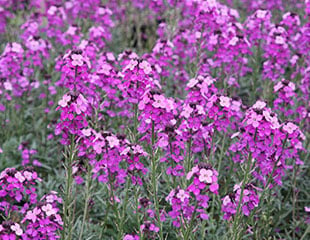
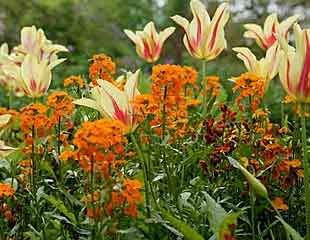
Wallflowers growing in Candie Gardens Guernsey
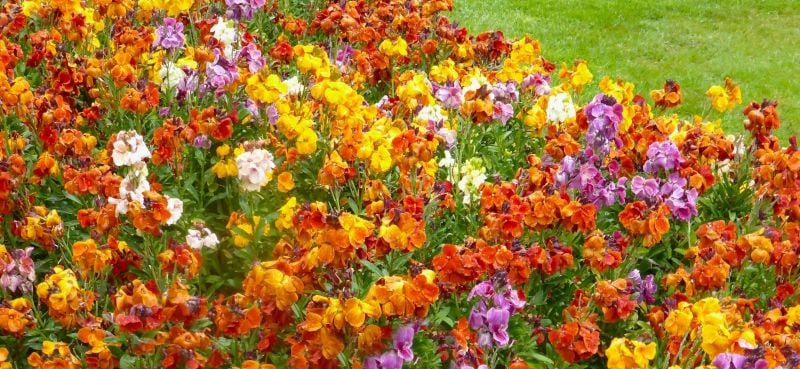

Wallflowers are a green wheelbarrow plant, being easy to grow and low maintenance.
